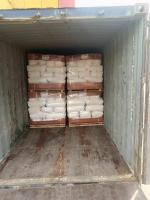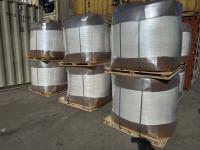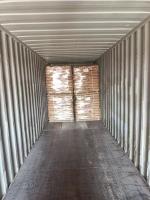Our Products
Polyacrylamide / lowerst price and best quality of Cationic polyacrylamide (CPAM) from Chinafloc

lowerst price and best quality of Cationic polyacrylamide (CPAM) from Chinafloc
Cationic polyacrylamide (CPAM) is a water-soluble polymer that has gained attention in various industrial and environmental applications. It is a type of polyacrylamide that is synthesized
through the copolymerization of acrylamide and a cationic monomer, such as dimethylaminoethyl methacrylate (DMAEMA), which imparts positive
charges to the polymer backbone.
CPAM has unique properties that make it useful in a variety of applications. It is highly water-soluble, and its positive charges enable it to interact with negatively charged surfaces such as clay particles and organic matter. This property
makes it an excellent flocculant and coagulant, which can be used to clarify and purify wastewater, drinking water, and other liquids. Additionally,
CPAM can be used as a thickening agent, emulsifier, and binder in various industries such as papermaking, textiles, and food processing.
One of the primary applications of CPAM is in wastewater treatment. In wastewater treatment, CPAM is used as a flocculant to aggregate and
settle suspended solids and other impurities, which can then be removed through sedimentation or filtration. CPAM is particularly effective in
treating wastewater from industries such as pulp and paper, textile, and food processing, which contain high levels of organic matter and
suspended solids.
CPAM is also used in drinking water treatment, where it is used to remove impurities such as bacteria, viruses, and organic matter. In addition,
CPAM can be used in the treatment of stormwater runoff to remove pollutants before the water is discharged into nearby bodies of water.
Another application of CPAM is in the papermaking industry. CPAM can be used as a retention aid, which helps to retain fillers, fibers, and other
additives in the paper pulp. CPAM also helps to increase the strength of the paper, reduce its porosity, and improve its surface properties. CPAM
can be added to the paper pulp at various stages of the papermaking process, depending on the desired properties of the final product.
In the textile industry, CPAM is used as a sizing agent to improve the strength and stability of the yarn. CPAM is also used as a flocculant in textile
wastewater treatment to remove suspended solids and other impurities before the water is discharged into the environment.
CPAM is also used in the food processing industry as an emulsifier and binder. CPAM can be used to stabilize emulsions, prevent sedimentation,
and improve the texture and mouthfeel of food products. CPAM is also used as a thickening agent in various food products such as sauces,
dressings, and soups.
Despite its numerous applications, the use of CPAM has some potential environmental concerns. CPAM is not biodegradable and can accumulate
in the environment, leading to potential adverse effects on aquatic and terrestrial organisms. In addition, the production of CPAM requires the use
of acrylamide, which is a neurotoxic and carcinogenic compound. However, the amount of acrylamide used in CPAM production is relatively low,
and appropriate safety measures can be taken to reduce the risk of exposure.
In conclusion, cationic polyacrylamide is a versatile polymer that has a wide range of industrial and environmental applications. Its unique
properties, including high water solubility and positive charges, make it an effective flocculant, coagulant, thickening agent, emulsifier, and binder.
However, its use should be carefully monitored to minimize its potential environmental impact. Further research is also needed to develop safer
Cationic polyacrylamide (CPAM) is a water-soluble polymer that has gained attention in various industrial and environmental applications. It is a type of polyacrylamide that is synthesized through the copolymerization of acrylamide and a cationic monomer, such as dimethylaminoethyl methacrylate (DMAEMA), which imparts positive charges to the polymer backbone.
CPAM has unique properties that make it useful in a variety of applications. It is highly water-soluble, and its positive charges enable it to interact with negatively charged surfaces such as clay particles and organic matter. This property makes it an excellent flocculant and coagulant, which can be used to clarify and purify wastewater, drinking water, and other liquids. Additionally, CPAM can be used as a thickening agent, emulsifier, and binder in various industries such as papermaking, textiles, and food processing.
One of the primary applications of CPAM is in wastewater treatment. In wastewater treatment, CPAM is used as a flocculant to aggregate and settle suspended solids and other impurities, which can then be removed through sedimentation or filtration. CPAM is particularly effective in treating wastewater from industries such as pulp and paper, textile, and food processing, which contain high levels of organic matter and suspended solids.
CPAM is also used in drinking water treatment, where it is used to remove impurities such as bacteria, viruses, and organic matter. In addition, CPAM can be used in the treatment of stormwater runoff to remove pollutants before the water is discharged into nearby bodies of water.
Another application of CPAM is in the papermaking industry. CPAM can be used as a retention aid, which helps to retain fillers, fibers, and other additives in the paper pulp. CPAM also helps to increase the strength of the paper, reduce its porosity, and improve its surface properties. CPAM can be added to the paper pulp at various stages of the papermaking process, depending on the desired properties of the final product.
In the textile industry, CPAM is used as a sizing agent to improve the strength and stability of the yarn. CPAM is also used as a flocculant in textile wastewater treatment to remove suspended solids and other impurities before the water is discharged into the environment.
CPAM is also used in the food processing industry as an emulsifier and binder. CPAM can be used to stabilize emulsions, prevent sedimentation, and improve the texture and mouthfeel of food products. CPAM is also used as a thickening agent in various food products such as sauces, dressings, and soups.
Despite its numerous applications, the use of CPAM has some potential environmental concerns. CPAM is not biodegradable and can accumulate in the environment, leading to potential adverse effects on aquatic and terrestrial organisms. In addition, the production of CPAM requires the use of acrylamide, which is a neurotoxic and carcinogenic compound. However, the amount of acrylamide used in CPAM production is relatively low, and appropriate safety measures can be taken to reduce the risk of exposure.
In conclusion, cationic polyacrylamide is a versatile polymer that has a wide range of industrial and environmental applications. Its unique properties, including high water solubility and positive charges, make it an effective flocculant, coagulant, thickening agent, emulsifier, and binder. However, its use should be carefully monitored to minimize its potential environmental impact. Further research is also needed to develop safer and more sustainable alternatives to CPAM in various applications.
and more sustainable alternatives to CPAM in various applications.





